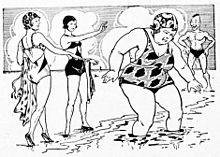Body shaming

Body shaming is the act of deriding or mocking a person's physical appearance. The scope of body shaming is wide, and can include, although is not limited to fat-shaming, shaming for thinness, height-shaming, shaming of hairiness (or lack thereof), of hair-color, body-shape, one's muscularity (or lack thereof), shaming of looks (facial features), and in its broadest sense may even include shaming of tattoos and piercings or diseases that leave a physical mark such as psoriasis.[1]
In a study of children's film and books regarding messages about the importance of appearance, media targeted for children were heavily saturated with messages emphasizing attractiveness as an important part of relationships and interpersonal interaction.[2] Among the movies used in the study, two Disney movies contained the highest number of messages about personal beauty. This study also found 64% of the videos studied portrayed obese characters as unattractive, evil, cruel, and unfriendly, and more than half of the portrayals involved the consideration or consumption of food.[3]
Some forms of body shaming have ancient origins in popular superstition, such as prejudice against red (or ginger) hair.[4] Forms of discrimination may also differ significantly depending on age group. For example, among preadolescents, tall tweens are sometimes depicted as awkward, and sometimes face derogatory pejorative terms such as "lanky". However, upon adulthood, such unflattering attitudes typically undergo a reversal as height is typically valued among adults.[1]
Sometimes body shaming can extend to a perception that one does not sufficiently display masculinity or femininity. For example, men with wide hips or prominent breasts or lack of facial hair are sometimes shamed for appearing feminine.[5] Similarly, women have been body-shamed for their lack of femininity for appearing to have a man-bulge,[6] or for having broad shoulders, traits that are typically associated with men.[5] Suicide because of the bodyshaming is the fourth leading cause of death in 15-19-year-olds. Extensive levels of body-shaming can have negative emotional effects, including a reduction in self-esteem and other issues such as eating disorders, anxiety, body image disturbance,[7] body dysmorphic disorder and depression.[8] Also, body shaming can lead to serious depression, especially when people feel their body can not meet social criteria.[9]
See also[]
References[]
- ^ a b Chen, Hong, and Todd Jackson. "Are cognitive biases associated with body image concerns similar between cultures?." Body Image 2.2 (2005): 177-186.
- ^ Herbozo, S.; Tantleff-Dunn, S.; Gokee-Larose, J.; Thompson, J.K. (2004). "Beauty and thinness messages in children's media: A content analysis". Eating Disorders. 12 (1): 21–34. doi:10.1080/10640260490267742. PMID 16864302. S2CID 12491583.
- ^ Greenberg, B.; Eastin, M.; Hofschire, L.; Lachlan, K.; Brownell, K. (2003). "Portrayals of Overweight and Obese Individuals on Commercial Television". American Journal of Public Health. 93 (8): 1342–1348. doi:10.2105/AJPH.93.8.1342. PMC 1447967. PMID 12893625.
- ^ Dettmar, Esther Katherine. Revising identification: fairy tales that transform tradition from within. Diss. University of Illinois at Urbana-Champaign, 2016.
- ^ a b Namaste, Ki. "Genderbashing: Sexuality, gender, and the regulation of public space." Environment and Planning D: Society and Space 14.2 (1996): 221-240.
- ^ https://www.ibtimes.co.uk/that-your-d-bella-thorne-body-shamed-posing-see-through-bra-top-boxer-1633094
- ^ Artoni, P.; Chierici, M. L.; Arnone, F.; Cigarini, C.; De Bernardis, E.; Galeazzi, G. M.; Minneci, D. G.; Scita, F.; Turrini, G.; De Bernardis, M.; Pingani, L. (2021-03-01). "Body perception treatment, a possible way to treat body image disturbance in eating disorders: a case–control efficacy study". Eating and Weight Disorders - Studies on Anorexia, Bulimia and Obesity. 26 (2): 499–514. doi:10.1007/s40519-020-00875-x. ISSN 1590-1262. PMID 32124409. S2CID 211728899.
- ^ Matheson, Mikayla. "Women’s Body Image in the Media: An Analytical Study of Recent Body Image Movements across Media Platforms." (2017).
- ^ Sick, Kelsey; Pila, Eva; Nesbitt, Amy; Sabiston, Catherine M. (September 2020). "Does self-compassion buffer the detrimental effect of body shame on depressive symptoms?". Body Image. 34: 175–183. doi:10.1016/j.bodyim.2020.05.012. PMID 32604022. S2CID 220282154.
- ^ Brewis, Alexandra A.; Bruening, Meg (May 2018). "Weight Shame, Social Connection, and Depressive Symptoms in Late Adolescence". International Journal of Environmental Research and Public Health. 15 (5): 891. doi:10.3390/ijerph15050891. ISSN 1661-7827. PMC 5981930. PMID 29723962.
- Social stigma